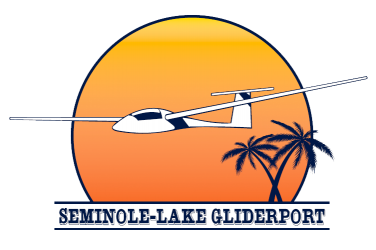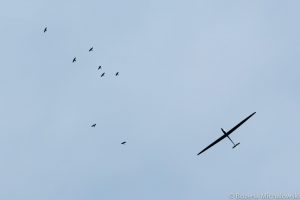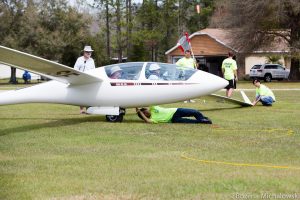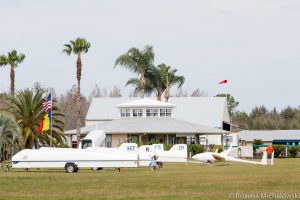2016 Senior Soaring Championship
2016 Senior Soaring Championship
By Rich Owen (with contributions from John Good and Rick Sheppe)
Cody…Cody, more on this in a moment.
In terms of pilot interest and participation, the Senior Soaring Championship ranks as one of the most popular events in the United States. It is the largest single class contest in the U.S. and this year (our 26th) we had some 93 entry applications for a contest that admits 55 regular entrants and 5 guests. Many pilots and crews arrived well ahead of time, and have enjoyed a week of first-ratepractice weather, which produced a good number of long flights including some over 500 km. Seminole-Lake Gliderport was in excellent condition: plenty of winter rain has produced green grass, but a dry spell resulted in a hard runway and good Florida thermals. The western side of the airfield looked like an RV dealership’s parking lot (we don’t yet have evidence that there’s an upper limit to the number of hookups that pilots will sign up for). Some of the regular visitors here are not glider pilots – though they do not lack soaring skills. From the airfield itself you can expect to see red tailed hawks, red shouldered hawks, turkey vultures, black vultures, sandhill cranes, wood storks, bald eagles and swallow tailed kites. On a task, pilots may add anhinga, cormorants, ospreys and various gulls. Florida easily ranks among the best places in the world for the number and variety of soaring birds, and for the help they can provide to human aviators.
On the day before the first practice day everyone noticed there were words being shouted about that you normally do not hear around the gliderport. Individuals were asking for “talent” (the person who is the main character in a production), did you get the “content” right (a story line) and “here is what I’m thinking”, (otherwise known as this is what the director wants to happen). A Travel Channel crew was on the field filming an episode about things to do around Florida which included a segment on soaring. Rich Owen was the lucky guy to be the focus of numerous gatherings of pilots trying to get him to laugh during the filming. Ky McAteer, our Contest Manager, did double duty as the photo ship pilot for the aerial sequences with the cameraman mostly outside the Super Cub’s door. The raw video of the DG-1000T in flight was amazing and we cannot wait till the episode airs in June.
The practice day started with coffee and donuts in the DG hangar as pilots straggled in, renewing friendships and saying hello to those who had just arrived in town. Our new Contest Manager, Ky McAteer, welcomed all the participants and started the pilot’s meeting right on time. The forecast was as good as the best of the previous 4 days but the actual weather didn’t turn out that way. In contrast to days when good climbs could be found at 6pm, this day began to die around 3:30, leaving a lot of pilots unable to reach the final turn area. The best result for the day was turned in by Karl Striedieck (in his brand new Duo Discus XL), at 58.5 mph.
At the next day’s briefing, Ky found out that the pilots at the Seniors do not allow for any breach of contest meeting etiquette. At the beginning of the meeting he forgot to allow the winner describe how he won the previous day. When this flagrant violation was brought up by the crowd he came back with “hey, he flew faster than all of you, get over it!” Laughter could be heard all the way to the parking lot!
The forecast for the first competition day was much less confident than for any of the previous 5 days. Fernando Silva, our weatherman, was wearing a blue and white striped shirt, which normally signifies blue skies with cu. However, we were told to expect plenty of cloud, a bit too much southeast wind, and near-total spreadout by mid-afternoon. In the face of this a short Turn Area Task was set, and the launch commenced promptly at noon into an already troubled sky. When the early launchers formed slow-climbing gaggles that steadily drifted downwind, confidence in a valid task day was low. But the low gliders hung on grimly, and our weather – in defiance of the forecast – slowly improved. Only three gliders needed a relight and the task opened shortly after 1pm as the sky continued to look better. Pilots who left home in a pessimistic mood returned with tales of 6 knot climbs to over 5000 feet, wondering why the task wasn’t an hour longer. Best for the day was Karl Striedieck in his Duo Discus XL, at nearly 70 mph over 120 miles. More than 50 pilots turned in a complete task, and we had just one outlanding (with no problems). Maybe Fernando was dressed correctly for the day after all!
Based on a pessimistic forecast for the next day, a crew rest day was announced. Remember, we had pilots arriving in January, and many had flown a number of good days leading up to the contest. On a tour around the gliderport we found an unusual sight: sandwiched between the T hangars and a trailer was a campsite for the Eagle Sport and Civil Air Patrol youngsters that comprise one of the best ground crews any contest manager could have. A travel trailer was set up with several tents, chairs, tables, boom boxes, and a very large sign that said “Camp JR (contest ID for the youngest entrant in the contest), no Seniors allowed”.
After a couple of non-flying days, the Senior Contest went back into business for contest day two. The forecast called for a hot (temperatures near 90), late-starting day with early low clouds giving way to weak, blue lift – to only modest altitudes. This less-than-stellar outlook led to a short (2 hr 15 min) Turn Area Task to the south. But the weather decided to show us something better. The early cu formed east-west cloudstreets that did not dissipate as the day developed. Before 1pm gliders were well above 4000 feet, on their way to over 5000 in the best part of the day. Many pilots saw occasional climbs of 6 knots, but most also found some trouble, including three who landed out.
Ken Sorenson (our SSA Chairman) was fastest for the day, at 65 mph over 160 miles. He found little sympathy with a tale of wondering what to do with a 9 knot climb just 15 miles from home on final glide (basic answer: stay with it for a long as you can rationalize, then streak home, high and fast). During the winner’s talk the next day, Ken gave us an update on many SSA initiatives that included a new Google Group for soaring clubs to discuss ways to improve, energizing youth programs, the importance of qualifying new flight instructors, and entering into a partnership with the EAA. That did not keep him from getting his daily prize of a bottle of “First Rate Old Fart” red wine. It was a particularly good vintage.
If you haven’t been to many contests, you may not know that they often feature a variety of four-legged visitors. Our dogs range from very well behaved companions like Kayley, to really mischievous twins like Darby and Wassee. However, Cody is the real character on the airfield. He is a very small 1black dog that has a very tall Canadian (who talks with a very German accent). Cody loves to roam and watch his owner run around chasing him. All over the RV park you can usually hear his name being called. Sometime during the evening of Day 2, Cody decided to pay a visit to the former US Team Captain’s trailer and leave a little moisture on the tire.
At the Day 3 morning briefing, Fernando told us to expect a long lasting soaring day with light winds and strengthening conditions throughout the afternoon. However he cautioned us that this forecast assumed that we would not be troubled by the cirrus that was expected both to our north and to our south. This posed the classic pilot’s dilemma: leave early enough to guarantee a safe return, or delay starting with the expectation that the day would both strengthen and last till sunset. Later in the meeting, Bif Huss gave a great talk about his retrieve from a landout at a local airport. Seems like the owner was a very private individual who had an impressive electrically operated gate at the entrance. After a good amount of time and consultation with the local Sheriff Deputy, Bif simply pulled the circuit breaker and the gate magically opened. Also this was the day for our group picture, for which competitors wear their favorite Hawaiian shirt. Ky, being the archetypal businessman, offered to rent shirts for the photo. Many took him up on the generous offer.
CD John Good set a 2:45 Turn Area Task going both north and south, using five circles. Most of the pilots left within half an hour of Task opening time and were on their way. A few, including Sam Zimmerman elected to trust the forecast and wait till the last minute.
Five turn areas offered a lot of options for gathering distance. But there was a trap awaiting some of them – the final Turn Area was bisected by prohibited airspace, and not everyone realized that fact before they made their turns in the second-to-last area. With only half a Turn Area available at the end, some found themselves undertime at the Finish. Thankfully, there were no airspace incursions.
The winners were Rich Owen at 64 mph, followed closely by Ron Ridenour and Jerry Zieba. In the end, Sam’s gamble did not pay off. He made good time until the day ended, and he started his engine after 163 miles, only ten miles from home.
In the overall standings after three racing days, Karl Striedieck and Ron Ridenour were virtually tied for first, and there were four others (Smith, Sorenson, Bennet, Owen) contending for second. We had only two more days to sort this all out.
At the end of the day in the DG hangar everyone enjoyed a catered roast beef dinner from Red Wing restaurant. Following dinner the US Team Committee made presentations about the Team while providing gourmet ice cream supplied by Janine Acee and the Penn State Creamery.
The fourth contest day was full of uncertainties. We knew we had unstable air, but the forecast was not definitive about how much sunshine we would get, to say nothing of where that sunshine would occur. We were sort of hoping for “thin cirrus” that would keep the heating low enough to prevent thunderstorms, but high enough to allow useable thermals to develop underneath. We knew for sure that the high clouds would thicken to our north and head our way.
The CD decided to send everyone south to a large Turn Area, and to bring them home via a small “steering turnpoint” to minimize conflicting traffic. To increase our chances of getting away in case the gliderport was under an overcast at start time, he increased the radius of the Start circle from 5 to 8 miles.
got lucky with the weather, and in fact, there were good thermals to 5500 feet under the milky cirrostratus, with no rain showers developing.
The task opened and most of the competitors left right away on what amounted to an out-and-return to an unspecified point in a large turn area. The conventional wisdom says you should follow the sandy Florida “ridge” marked by highway 27. This route takes you to the eastern side of the large turn area. The other strategy was to follow the wind line to the western side. It was interesting to watch the fleet split into these two groups on the SSA tracker page.
With one exception, the western group did better. Ken Sorenson won the day at 72 mph by following the energy, circling only five times, and making a perfectly timed 37-mile final glide. Don Kroesch and Dennis Linnekin made similar flights, but were significantly slower than Ken. The eastern group was led by Sam Zimmerman, who turned in a speed of 68 mph. After handicapping, the top three were Sorenson, Zimmerman, and Billy Kerns.
The last day’s weather offered a good case of “choose your forecast” – various sources offered everything from pretty good to hopeless. All of them suggested we’d be getting too much moisture on west winds from the Gulf of Mexico. The best of them said that this would leave plenty of holes for enough solar heating to produce good thermals. The worst spoke of near-solid layers of cloud, poor heating, and even some rain.
At the last contest day pilot’s meeting we like to introduce the young adults that comprise our ground launch crew. This year we had 10 youngsters and 3 adults from the Civil Air Patrol and Eagle Sport Aviation (flying club from Embry Riddle Aeronautical University). They were lead by Sue Martin who has done so much for Seminole-Lake Gliderport and the future pilots currently in college in the local area. She is the Civil Air Patrol’s glider program manager for the Florida Wing and runs several glider encampments throughout the US during the summer. Her crew is comprised of both airplane and glider pilots, and a student in an A&P program. We are very proud of the contributions these young men and women made during the contest.
We gridded gliders at noon, just in time for a P-51 Mustang flyby, courtesy of Stallion 51, based in nearby Kissimmee. We then waited for some holes to appear in the thick overcast. They did, but were insufficient. The final day was cancelled around 1 pm, and little complaint was heard (most pilots worth their salt would be happy to stand around far longer for a chance to see – and hear – four Mustangs rumble by in formation).
With all the aircraft in the box, everyone prepared for an outstanding evening at the Mission Inn Golf and Resort. As the sun was going down over the golf course and everyone was enjoying their favorite adult beverage it was easy to see why so many travel to central Florida for this contest. The dinner was excellent and the awards presentation honored all the competitors. A special treat was the viewing of drone footage that was taken during the contest by CS Drones, a commercial operation based in Florida. When the video was edited and released, we had over 12,000 views in the first 2 hours it was up. Please see it at: https://vimeo.com/160381774. Our drone friends so loved the gliderport, they chose to have their wedding in our hangar the following week. Congratulations to Crystal and Sasha Marvin!
So the 26th Senior Soaring Championship is over. Ken Sorenson is the winner, thanks to a couple of excellent flights. Karl Striedieck takes silver, and Ron Ridenour bronze. We had a safe contest with four decent contest days (many pilots enjoyed four more very good days in the week before the contest). As a new Contest Manager, Ky McAteer did an outstanding job. Unfortunately, his business will not allow him to reprise his role for next year. Jim Price (no stranger to flying and running big contests) will take over the reins of the Contest Manager for the Seniors and return with the rest of the contest crew next year. Seminole-Lake Gliderport has enhanced its already formidable reputation as a soaring training destination and contest site. Many plans are in the works to make it even better. Hope to see all of you next year!
Would you like to fly at our Glideport?
Schedule a flight


